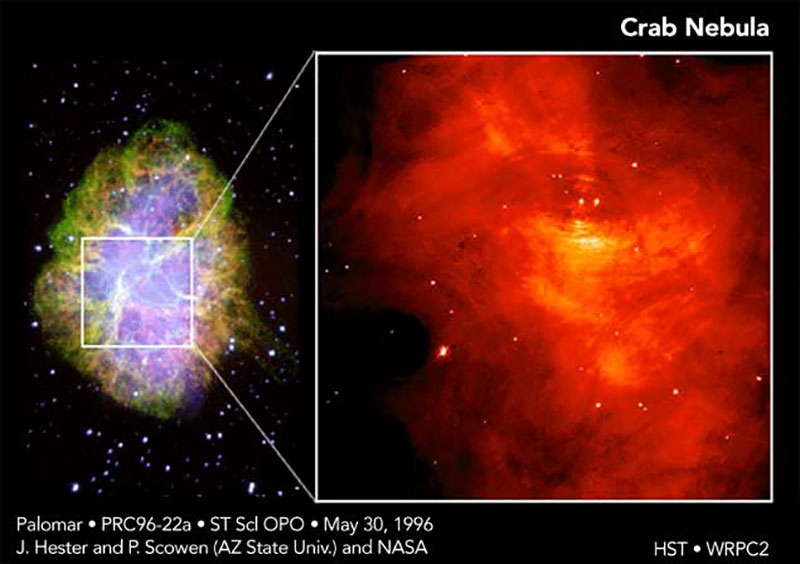Pulsar
Afterlife of Stars
After a supernova explosion has occurred, sometimes a dense ball of neutrons remain in the core of the star and form what is known as neutron star. Typical neutron stars are very small, no more than 20 km in diameter. However, they have a great deal of mass, much greater than even our Sun. A neutron star can send pulses of energy and light that can be detected as radio signals and is known as a pulsar. In some regions of space, the pull of gravity is so great that nothing–not even light–can escape. These regions or black holes were possibly caused by the collapsing of very massive neutron stars. Certain distant galaxies have centers that are a hundred times brighter than ordinary galaxies. These centers are called quasars (quasi-stellar objects) and are probably very large black holes that are drawing in all sorts of glowing stellar matter..
After a supernova explosion has occurred, sometimes a dense ball of neutrons remain in the core of the star and form what is known as neutron star. Typical neutron stars are very small, no more than 20 km in diameter.

Pulsar
However, they have a great deal of mass, much greater than even our Sun. A neutron star can send pulses of energy and light that can be detected as radio signals and is known as a pulsar.
A new sequence of Hubble Space Telescope images of the remnant of a tremendous stellar explosion is giving astronomers a remarkable look at the dynamic relationship between the tiny Crab Pulsar and the vast nebula that it powers. The colorful photo on the left shows a ground-based image of the entire Crab Nebula, the remnant of a supernova explosion witnessed over 900 years ago. The nebula, which is 10 light-years across, is located 7,000 light-years away in the constellation Taurus. The green, yellow and red filaments concentrated toward the edges of the nebula are remnants of the star that were ejected into space by the explosion. At the center of the Crab Nebula lies the Crab Pulsar — the collapsed core of the exploded star. The Crab Pulsar is a rapidly rotating neutron star — an object only about six miles across, but containing more mass than our Sun. As it rotates at a rate of 30 times per second the Crab Pulsar’s powerful magnetic field sweeps around, accelerating particles, and whipping them out into the nebula at speeds close to that of light. The blue glow in the inner part of the nebula — light emitted by energetic electrons as they spiral through the Crab’s magnetic field — is powered by the Crab Pulsar. The picture on the right shows a Hubble Space Telescope image of the inner parts of the Crab. The pulsar itself is visible as the left of the pair of stars near the center of the frame. Surrounding the pulsar is a complex of sharp knots and wisp-like features. This image is one of a sequence of Hubble images taken over the course of several months. This sequence shows that the inner part of the Crab Nebula is far more dynamic than previously understood. The Crab literally “changes it stripes” every few days as these wisps stream away from the pulsar at half the speed of light. The Hubble Space Telescope photo was taken Nov. 5, 1995 by the Wide Field and Planetary Camera 2 at a wavelength of around 550 nanometers, in the middle of the visible part of the electromagnetic spectrum. Credit: Jeff Hester and Paul Scowen (Arizona State University), and NASA.
